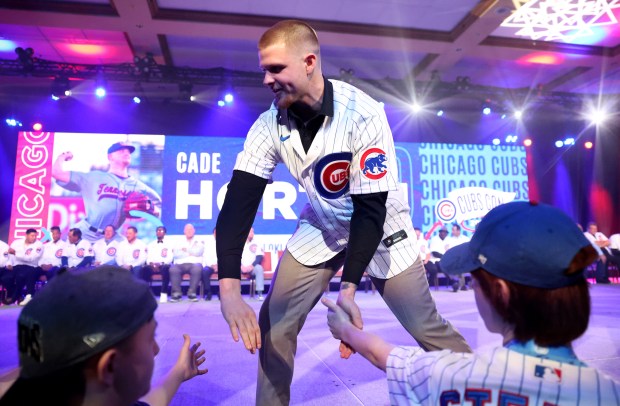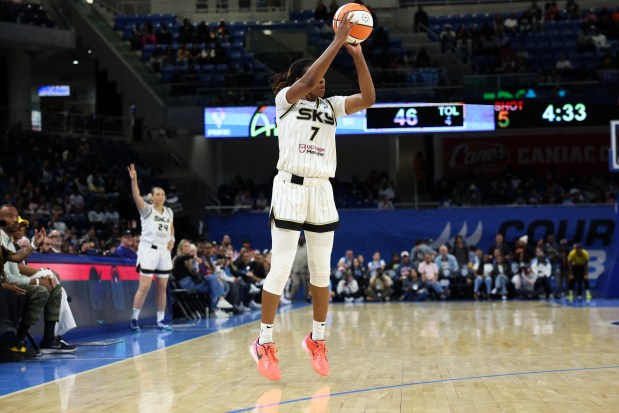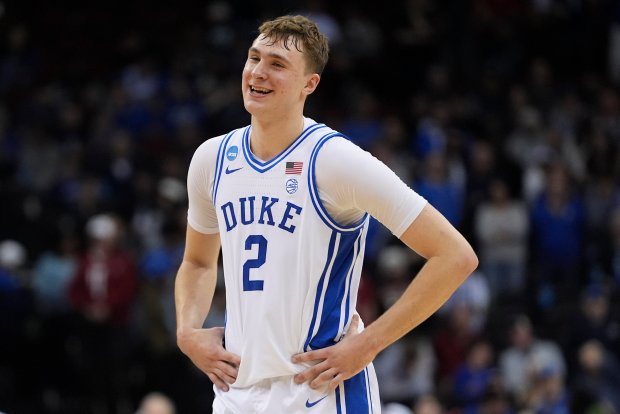NEW YORK — Cade Horton knew pretty quickly something was up.
Triple-A Iowa pitching coach Tony Cougoule summoned Horton from his Toledo, Ohio, hotel room to head up to manager Marty Pevey’s room because he had been named the league’s pitcher of the month.
“In my head, I’m thinking, ‘I think that was given out like a week ago. I didn’t win it,’ so red flag there,” Horton recalled Friday.
Once Horton met Pevey, the skipper didn’t wait long to share the news: The Cubs were calling up the 23-year-old, who joined the team in New York. Horton was at Citi Field on Friday as part of the taxi squad and will be added to the roster Saturday.
His promotion comes nearly a year after Horton suffered what became a season-ending right shoulder injury.
“It’s been crazy, but I think it’s a testament to all the hard work I’ve put in this offseason and just the strides I’ve made, maturing and really knowing it’s my time,” Horton said.
Horton will wear No. 22, which notably once was donned by another standout right-hander the Cubs selected in the first round, Mark Prior. That was unintentional by Horton, however. All of Horton’s favorite numbers were unavailable, so he went with No. 22. After making the selection, he looked up to see who else had worn it with the Cubs and saw Prior’s name.
“I thought that was pretty cool,” a grinning Horton said.
Horton did not dwell on the possibility of a big-league call-up when he learned left-hander Shota Imanaga landed on the 15-day injured list with a left hamstring strain.
“I really tried to focus this year on just being where my feet are and I didn’t want to play GM because when you play GM, it just never works out that way,” Horton said. “Just really waiting. And I wanted it to be a cool moment, like me not expect it, so I kind of was focusing on just controlling what I can.”
Before Friday’s series opener, manager Craig Counsell wouldn’t commit to how Horton would be used, whether starting the next game or coming in after an opener — let alone if he would be making his MLB debut Saturday. Counsell wanted to get through Friday’s game to see where the staff was at, only confirming Horton would be active Saturday.
“He’s the guy that’s pitching the best in Iowa so the player that most earned the opportunity, and he’s off to a great start this season,” Counsell said. “Just mound reps, getting your delivery locked in and hadn’t been out there for most of 2024, so he’s got himself in a really good place and pitching really well.”
Horton’s performance in his six starts with Iowa this season left little doubt he was ready for the next challenge. He posted a 1.24 ERA and pitched six innings in his last two starts while walking only three batters and striking out 15 in his last 16 2/3 innings.
“You always want it this way — he’s been pitching well and it’s hard to ignore that,” Counsell said. “He’s a young starting pitcher who did have an injury last year. He’s learning every time he goes out there. He’s learning about himself as much as anything, and these are really valuable experiences for him so this is a lot of growth.
“He’s a talented, talented pitcher that if we laid a good foundation for him you suspected that he was going to make an impact on this team.”
The Cubs could have optioned to go with a full bullpen day and not bring up Horton until the next turn in the rotation, which would align for their series next weekend against the White Sox at Wrigley Field. Pitching coach Tommy Hottovy acknowledged Wednesday that an ideal situation likely would involve a softer landing spot for a pitcher making his debut than the challenging Mets lineup. But, conversely, starting at Wrigley is a big experience for any young pitcher coming up, Hottovy noted.
“I don’t really see a huge difference either way,” Hottovy said Wednesday. “I do think sometimes when guys make their debuts on the road, it’s a little less pressure because it’s not the full media scrum that you would get when you’re in Chicago. But yeah, I don’t really have a personal preference.”
Once Horton’s mechanics were ironed out in spring training following the long layoff with his right shoulder injury, the Cubs challenged him to locate his slider and curveball in the strike zone, especially early in counts. The Cubs knew Horton’s elite stuff could generate chase and whiff even when he doesn’t have his best command, but those two offspeed pitches and the spin they create present a different angle. It won’t let big-league hitters, who are better equipped with plans, to sit on his fastball.
Hottovy credited Horton for taking ownership of that challenge.
“It’s a lot easier to pitch when you can land more than one thing,” Horton said. “And so it’s really helped me cut down walks and get soft contact.”





